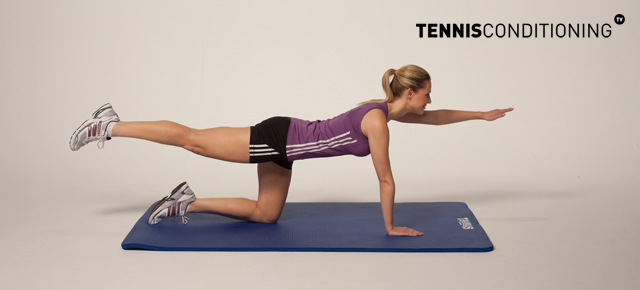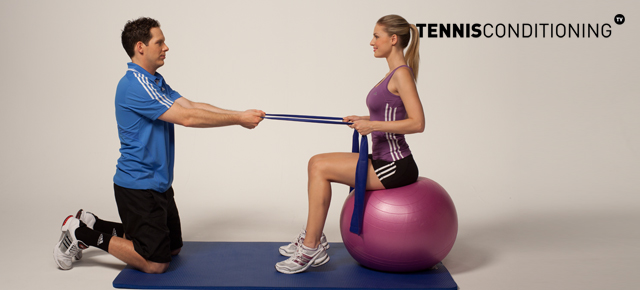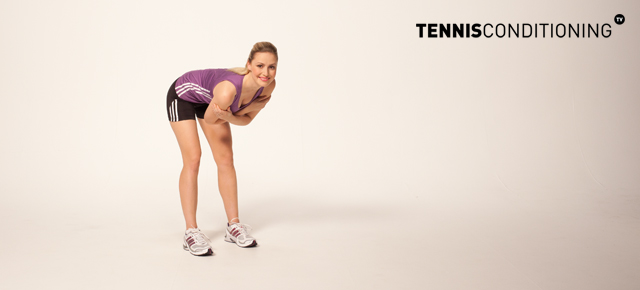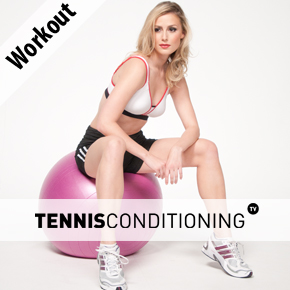Lower back strengthening is important to decrease the risk for injury and enhance core strength & stabilization.
Many athletes experience low back pain due to flexibility issues and/or strength imbalances of the low back musculature causing posterior pelvic tilting, which leads to ineffective transfer of energy and injuries.
Since the low back is part of the core, and the core is essential in energy transfer due to so many connection points in the movement chain, lower back strengthening should occur regularly to enhance energy transfer and hence performance.
For more info on the subject take a look at Why Core Training for Tennis Players Is Important.
Next we have some more lower back strengthening exercises you can use with all your athletes, from beginners to professionals. To watch the single lower back strengthening videos simply click on the respective headlines.
Lower Back Strengthening Exercises
Romanian Deadlift – RDL

- Position barbell on the rack; add resistance (plates) and attach safety clips; place barbell on the ground
- Take an athletic stance; stand straight, feet are shoulder-width apart; knees slightly flexed; toes point slightly outward (10˚-20˚)
- Use a pronated grip (palms facing down) and place hands just wider than shoulder-width on the bar; take barbell off the rack; stand up straight
- First flex hips (~45˚) to 90˚ (or as far as possible) without additional knee flexion; distribute weight through the heels; keep knees inside shoulders; maintain neutral spine position (push chest out and scapulae [shoulder blades] together; maintain neutral head position [look forward])
- Extend the knees and hips while maintaining neutral spine position and return to starting position
Supine Bridging

- Place floor mat on the ground
- Lie flat on the floor mat (face up) with arms close to the trunk (palms down)
- Knees are in line with shoulders
- Bring heels toward the buttocks until knees are flexed at 90˚
- Extend hips upwards to neutral pelvic position; hold position for 1 second
- Descend hips back to the ground
4 Point Prone Contra-Lateral Limb Raises

- Place floor mat on the ground
- Position hands and knees on the floor mat (face down) with arms extended and hips & legs flexed at 90˚ (palms down); arms are underneath the shoulders and knees are in line with shoulders
- Raise opposite limbs (arm & leg) simultaneously; extend chest and retract the scapular throughout the movement; hold 1 second and descend; keep looking forward during movements
4 Point Prone Physioball Contra-Lateral Limb Raises

- Lie on top of the physioball with the hips and trunk
- Position hands and knees on the ground (face down) with arms and legs extended; arms are underneath the shoulders and knees are in line with shoulders
- Raise opposite limbs (arm & leg) simultaneously; hold 1 second and descend; extend chest and retract the scapular throughout the movement; keep looking forward during movements
Assisted Prone Physioball Trunk Extension

- Coach stabilizes lower-extremities (legs).
- Lie on top of the physioball with the hips and trunk
- Fold hands in front of the chest and extend legs; knees are in line with shoulders
- Raise upper-body; hold 1 second; extend chest and retract the scapular throughout the movement; keep looking forward during movements
Assisted Prone Physioball Unilateral Leg Extension

Coach stabilizes physioball.
- Lie on top of the physioball with the hips and trunk
- Place elbows and hands on the ground; knees are in line with shoulders
- One leg maintains ground contact; raise other leg to neutral spine position; hold 1 second; extend chest and retract the scapular throughout the movement; keep looking forward during movements
Assisted Seated Physioball Hip Flexion to Extension

Coach kneels on the ground and assists movement via elastic band.
- Sit upright on top of the physioball; hips and legs flexed at 90˚; knees are outside shoulders
- Hold elastic band in both hands; arms remain straight during movement
- Coach pulls elastic band towards himself/herself; athlete simultaneously flexes hips and maintains neutral spine position during movement; hold 1 second; extend chest and retract the scapular throughout the movement; keep looking forward during movements
- Athlete extends hips thereby returning to seated position; coach provides resistance
Standing Hip Flexion to Extension

- Stand upright in athletic stance; knees are slightly flexed and under the shoulders
- Cross arms in front of the chest
- Knees remain in position but will flex automatically; flex hips and lower upper-body towards the ground and hold 1 second; extend chest and retract the scapular throughout the movement; keep looking forward during movements
- Return back to starting position
Training Zone
In this section we provide you with some more resistance training workouts you may be interested in to optimize your training:
Before you start your workout you may want to warm up to prepare yourself and minimize the risk for injuries.
Don’t forget to stretch out afterwards to enhance flexibility and reduce muscle soreness the next day.

